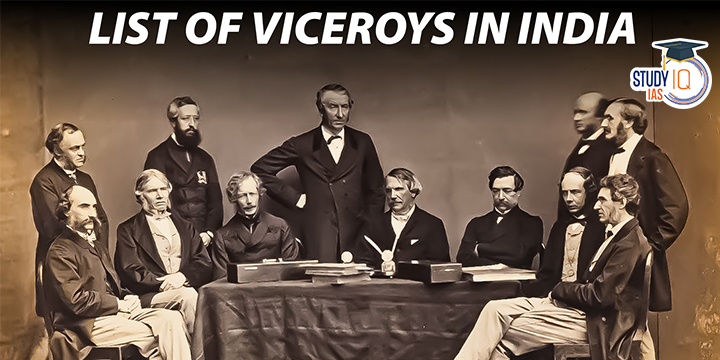Table of Contents
Viceroy of India
List of Viceroy of India: The governor-general of India, formerly known as the viceroy of India, served as the monarch of the United Kingdom’s representative, and upon Indian Independence in 1947, the viceroy took on the role of the head of state of India. A Viceroy refers to a delegate of a King or queen who governs another nation on behalf of that monarch. Following the uprising in 1857, the British took over the Viceroy’s position and authority. Governor Generals ruled India prior to the Viceroy. Lord Canning, the first viceroy of India, controlled the country from 1856 to 1862.
List of Viceroy of India from 1856 to 1947
Here’s the complete List of Viceroy of India from 1856 to 1947:
|
Viceroy |
Tenure |
Achievements |
| Lord Canning | 1858-1862 |
|
| Lord Elgin | 1862 – 1863 |
|
| Lord Lawrence | 1864 – 1869 |
|
| Lord Mayo | 1869 – 1872 |
|
| Lord Northbrook | 1872 – 1876 |
|
| Lord Lytton | 1876 – 1880 |
|
| Lord Ripon | 1880 – 1884 |
|
| Lord Dufferin | 1884 – 1888 |
|
| Lord Lansdowne | 1888 – 1894 |
|
| Lord Elgin II | 1894 – 1899 |
|
| Lord Curzon | 1899 – 1905 |
|
| Lord Minto II | 1905 – 1910 |
|
| Lord Hardinge II | 1910 – 1916 |
|
| Lord Chelmsford | 1916 – 1921 |
|
| Lord Reading | 1921 – 1926 |
|
| Lord Irwin | 1926 – 1931 |
|
| Lord Willingdon | 1931 – 1936 |
|
| Lord Linlithgow | 1936 – 1944 |
|
| Lord Wavell | 1944 – 1947 |
|
| Lord Mountbatten | 1947-48 |
|
Viceroy of India History
A royal charter from Queen Elizabeth I allowed the British to enter India as traders. The British began their authority in India through trading, and they quickly acquired control of the country’s trading activities. The fortification of William was under the supervision of a governor-general in Kolkata. The East Indian Company lost control of the area following the uprising of 1857, and the Crown took it. The Viceroy of India replaced the term “Governor General” in the title. Lord Canning served as the country’s first viceroy, while Lord Mountbatten served as the country’s final viceroy. Chakravarti Rajagopalachari was the only Indian after independence to hold the position of Viceroy of India.
Viceroy of India UPSC
- The British government directly appointed the Viceroy.
- Lord Canning served as India’s first viceroy.
- Following the Revolt of 1857, the Indian government established the post in 1858. The role of Governor-General of India was superseded by the Viceroy of India, who represented the British crown. Lord Mountbatten was the last viceroy of India
- Chakravarti Rajagopalachari served as India’s Last governor general from 1948 to 1950.


 Nagari Pracharini Sabha Revival: Backgro...
Nagari Pracharini Sabha Revival: Backgro...
 Ryotwari System in India, Features, Impa...
Ryotwari System in India, Features, Impa...
 Battle of Plassey, History, Causes, Impa...
Battle of Plassey, History, Causes, Impa...





















